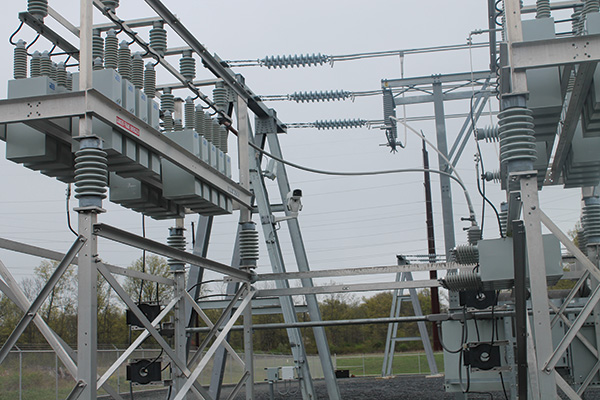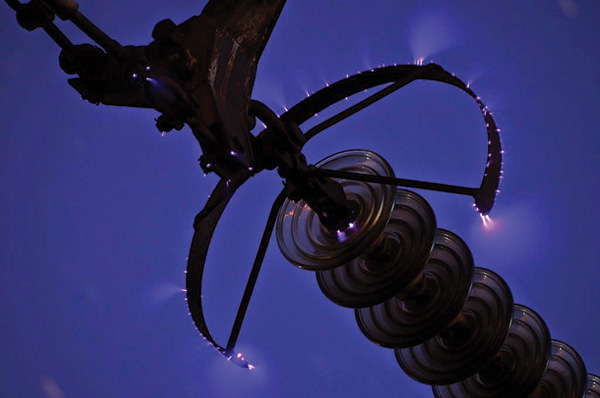Overview
Sensing technologies exist to monitor the most critical assets and processes in an electric power system, whose fault could cause extensive and expensive outages for the utility and strain the system as it is forced toreroute power delivery. In the past, only a few of these sensors or monitoring devices had the capability to report their readings to a SCADA system. Most of the data obtained from these sensors had to be obtained manually through a gauge, and many critical measurements, like oil quality of the transformers,could only be done offline using samples. In recent years, improvements in power consumption and communications in sensor technology not only has reduced the cost of asset monitoring but also allowed remote online data gathering, creating new horizons for condition monitoring systems for electrical substations.
Sensors in the Substation
Every major asset or process in a substation is being monitored using some sort of sensor. Transformers, breakers, arresters, capacitor banks, etc., all have a mechanism to monitor their operating condition and assess the risk of damage or need for maintenance. Although sudden failures of these critical assets do not happen often, they can have catastrophic consequences, and online monitoring can reduce the probability of these events to occur to almost zero.
Inside a substation, for example, the most expensive asset and the one that is the most monitored is the transformer. Failure of a transformer causes major outages, costly repairs and strain on the surrounding system as power must be routed from other sources while the repair is being done. Utilities do as much as they can to maintain the transformer to prevent these failures. A power transformer may have more than 100 sensors that are monitoring not only primary components such as the windings, tap changers and bushings but also the protective components such as the cooling system. The most catastrophic failure of the transformer is in the breakdown of the winding insulation. Accelerated insulation aging and failure are caused by overheating of the windings resulting from overcurrent incidents. Extensive protection and control systems are used to provide as much protection as possible for the transformer from overcurrent faults that will cause overheating. Even with protection and control schemes in place, faults will be felt by the transformer, and it needs to be monitored for signs of wear. This will provide the maintenance group with information on what parts of the transformer need attention.

The following is a description of different monitoring processes that used to be manual and now can be automated and measured online:
Transformer Temperature
Keeping the winding temperature in the optimal range will maximize the service life of the transformer. Temperature, moisture content and oxygen are the contributors to the deterioration of insulation with temperature being the primary. The primary contributor to insulation temperature is the heat generated by load losses.1
The overall average temperature of the windings could be an indication of the load on the transformer as well as the operation of the transformer cooling system. Fiber optic sensors can now detect subtle changes in temperature in the windings and report them to SCADA in real time. Winding hot spots could be an indication of insulation failure in a particular area and could be the result manufacturing defect, mechanical fault or partial discharge. Mechanical faults could be caused by seismic activity, transporting the unit and temporary overcurrent faults. Monitoring for and protecting from excessive winding temperature is vital to preserving the life of the transformer.
Monitoring the oil temperature in the transformer also provides an indication of winding hotspots and the performance of the oil cooing system. In turn, many parts of the cooling system can be monitored such as the oil level, oil flow, oil pumps, cooling fans, radiators, pressure and filters.
Online Dissolved Gas Analysis (DGA)
DGA analysis is a known and accepted method of evaluating transformer health. As insulation breaks down it generates gases inside the transformer and DGA is recognized as the most informative method for detecting those gases.3 Traditionally, DGA required the oil samples to be taken from the transformer and transported to a lab for analysis. The manual sampling was done on a periodic basis but was recommended to be done at least annually. Advances in sensors, analysis and communication technology now allow DGA to be done online, remotely and continuously. Online monitoring provides more accessible data that allows more accurate trending analysis and indication of sudden changes. Time-stamped data allows correlation of changes with electrical disturbances. Online DGA can detect not only the deterioration of insulation but also a probable cause and is an important input into a condition-based maintenance program.
Partial Discharge Monitoring
Partial discharge (PD) is an electrical discharge across an area of insulation. It can be caused by damage or manufacturing imperfections in the insulation and can cause the further, accelerated deterioration of the insulation over time once initiated. PD results in a localized release of energy that produces a number of effects: chemical and structural changes in the insulating material, electro-magnetic effects, heat and sound2. Since PD releases energy in different forms, there are a number of different ways to detect its presence. Some of the methods are listed below:
- If PD occurs in the insulation inside a transformer, the changes in the insulation will release chemicals into the insulating oil that can be detected using dissolved gas analysis.
- The release of energy causes electromagnetic pulses in the UHF band to be released. The pulses can be filtered and detected with UHF sensors and with triangulation techniques can approximate the location of the source of the PD.
- Sound is also produced in a specific frequency band as a result of PD. Similar to UHF detection, the sound can be filtered, and the source can be approximated using triangulation techniques.
- Current flow through the insulation will cause resistive heating along the path that can be detected with infrared imaging cameras or other heat detection methods such as resistive temperature sensors.
- Partial discharge can be detected in metal switchgear cabinets using Transient Earth Voltage, (TEV), measurements.
A combination of sensors that detects each of the previous physical indications of this phenomena, supported by algorithms of pattern recognition, can now provide early warning of the deterioration of a critical component in the substations, so a proper maintenance plan that optimizes resources can be set in place before a catastrophic event occurs.
Corona Discharge
Corona discharge is the electrical discharge usually through ionized air that is surrounding high voltage conductors. Corona can have several negative side effects such as power loss, audible noise, electromagnetic noise, generation of gases that can lead to insulation damage and conductor corrosion. It is advisable to detect and eliminate corona discharge to avoid losses and before damage to insulation or conductors is great enough to cause a flashover and further damage to the surrounding equipment and personnel. Corona discharge can be detected using ultrasound or ultraviolet light monitoring equipment.
- Ultrasound - Corona discharge emits sound at a higher frequency than humans can hear. The monitoring equipment can detect the sound and modulate down to a frequency that humans can hear. Using a parabolic dish, the sound source can be pinpointed.
- Ultraviolet radiation – emitted during corona discharge can be detected using UV cameras. The cameras detect the ultraviolet light and modulate into a band that can be seen by the human eye. This method can be used in daylightif filters are applied to block out the UV that is radiated from the sun that would interfere with the image. The UV cameras are very effective since they allow the operator to “see” exactly the points of corona discharge.

General Temperature Monitoring
Many processes in the substation generate heat as a by-product. This heat, or lack of heat, can be normal, but many times it is also an effective way to detect impending faults in the system. Most failures that involve partial discharge or the corona effects will show increasing temperatures as the fault becomes more severe due to the I2R factor. Increased temperature can also indicate different types of connection problems. Loose, dirty, corroded or over-tightened connections will have less surface contact area and will show increased temperature as a result. Joints and splices that are defective or that have degraded over time, will also heat up as a result. Switch contacts that do not engage fully or properly will have less surface area and will overheat and cause damage to the switch. Temperature can be measure in any of the following ways:
- Resistive Temperature Detectors or RTDs are simple, inexpensive devices that measure temperature by changing resistance as applied temperature changes. The challenging part of implementing RTDs is the installation of the power and communication infrastructure that connects them to a real-time monitoring system.
- Fibre Optic temperature measurement of transformer windings has some advantages over their electrical counterparts because of higher bandwidth, immunity to electromagnetic interference, multiplexing capability and ease of remote sensing.4 Fibre optic sensors are capable of finding a winding hotspot temperature more accurately than oil temperature measurement. Using fibre optic sensors enables the preventive measures to be deployed to reduce damage to winding insulation more reliably than other methods. The disadvantage is the fibre optic sensors must be installed during manufacturing or rebuild/repair of the transformer.
- Infrared measurements are useful in that no direct attachment to a device or asset is required to read the temperature. Installation is, therefore, easier than installing RTDs on each point. An infrared camera can monitor many assets and points if set on an automated, preprogrammed scanning sequence. Care must be taken since many environmental conditions can affect the accuracy of the measurement including ambient temperature, humidity, wind and the emissivity of the object being measured. Generally, a comparative measurement between like components on different phases to locate problem areas is recommended to negate the environmental effects.
New Applications
Applications for deploying sensing and monitoring technologies have typically been used in substations to monitor high-value assets such as transformers and breakers. Technology advances in sensors themselves, as well as in the network communications and processing of data, is making it more feasible to deploy sensors in other areas both inside and outside of the substation. Predictive analytics, health indices and scheduling tools make it more manageable to deal with the huge amounts of data that come from deployed sensors.
Underground system monitoring, for example, is an application that is gaining interest among utilities. Utilities have little or no visibility of the components in their underground system until an outage occurs. Most vaults are not monitored and have neither communications nor power sources available. In many areas, underground vaults are prone to flooding, which can lead to advanced aging of the system insulation, joints and splices. Providing the utility with online information on the health of the system will help them to find and fix faults before an unplanned outage occurs. With new, low-power sensors and communications technology, it is possible to harvest small amounts of power from the underground vault or to power the sensors from a long-life battery.
Summary
Sensors are continuously evolving; becoming more sophisticated, smaller, less expensive and with improved networking capabilities. These technological advances now allow remote and online gathering of data that used to be done manually. The flow of data coming from sensors in the field can now be used to predict problems with critical assets and processes and thus prevent unplanned outages. All these measurements that once required manual data gathering can now be obtained periodically and automatically by a monitoring system. The data can be analyzed to recognize patterns that can predict when a component must be replaced.
The decreasing cost and size of sensing and monitoring equipment mean the return on investment can be realized sooner with the advancing technology. Sensors can be used in a wider range of applications such as overhead lines and underground systems that previously were too expensive to monitor. As increasing numbers of sensors become deployed the electric power system will become more reliable, and utilities will be able to use maintenance resources more efficiently.
 Richard Harada has more than 20 years of experience in industrial networking communications and applications. Prior to joining Systems with Intelligence, Harada worked at RuggedCom and Siemens Canada, where he focused on product management and business development for industrial communications in the electric power market. Harada is an electronic engineering technologist and has a Bachelor of Science degree in computer science from York University in Toronto.
Richard Harada has more than 20 years of experience in industrial networking communications and applications. Prior to joining Systems with Intelligence, Harada worked at RuggedCom and Siemens Canada, where he focused on product management and business development for industrial communications in the electric power market. Harada is an electronic engineering technologist and has a Bachelor of Science degree in computer science from York University in Toronto.
 Edgar Sotter has a Bachelor of Science in electrical engineering from Universidad del Norte in Colombia and a doctorate degree in electronic engineering from Universidad Rovira I Virgili in Spain. Sotter’s fields of expertise are in sensing and monitoring systems and computer networks. Sotter has past experience working at Siemens/RuggedCom, and he is currently managing the service and support team at Systems With Intelligence, where he has been for the past eight years.
Edgar Sotter has a Bachelor of Science in electrical engineering from Universidad del Norte in Colombia and a doctorate degree in electronic engineering from Universidad Rovira I Virgili in Spain. Sotter’s fields of expertise are in sensing and monitoring systems and computer networks. Sotter has past experience working at Siemens/RuggedCom, and he is currently managing the service and support team at Systems With Intelligence, where he has been for the past eight years.
References:
1. Effects of Environmental Factors in Transformer’s Insulation Life
2. Application of Acoustic Emission Discharge Detection Method for Online Condition Monitoring of Power Transformers
3. Dissolved Gas Analysis for Transformers - NWwtr09_Hamrick
4. Temperature Monitoring of Power Transformer using Fibre-optic Sensor






